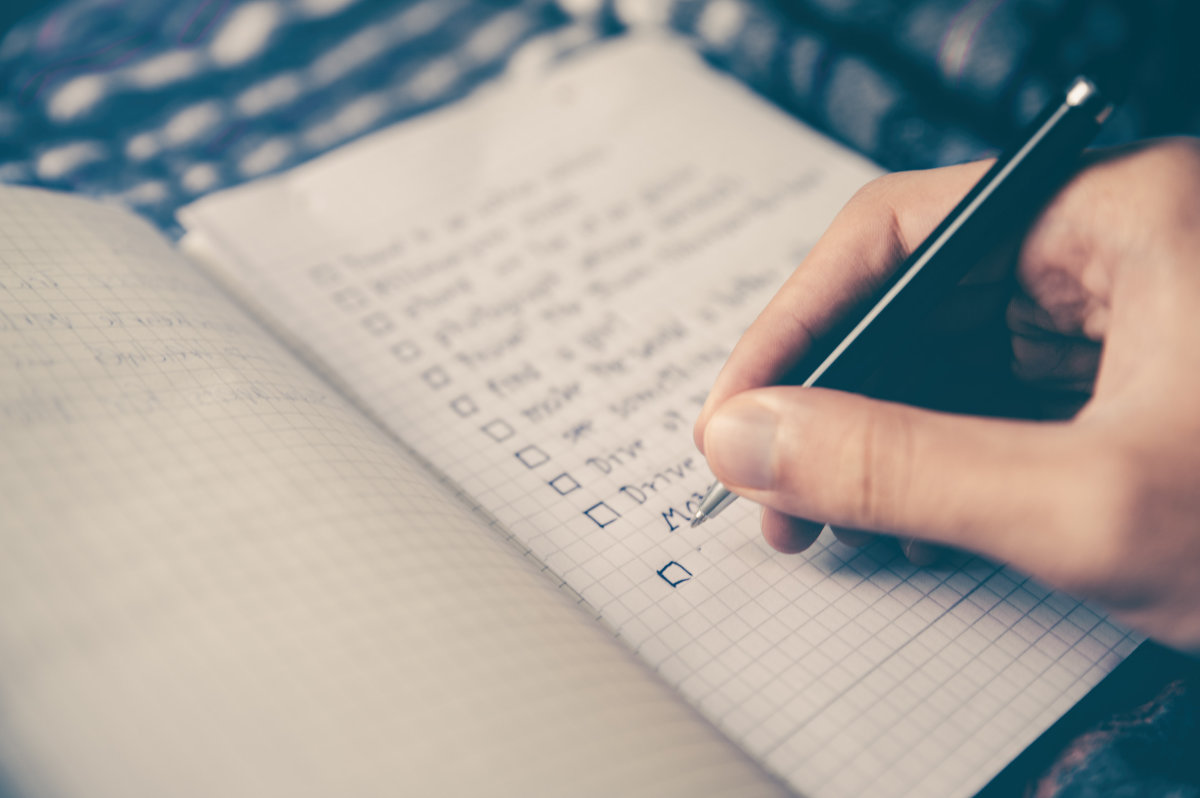
Helpful hints
General planning
Here are some helpful hints that may make your daily life easier in coping with Tremor. The list is not exhaustive, but we hope it will assist you and may even help you to discover other tips and tricks that will be useful in your specific situation. Remember that safety is paramount.
Top tips
- When possible try to plan ahead and work out what you want or need to do, and when is best to do it
- Set priorities so the most important things are comfortably achieved
- Take frequent rests between tasks and alternate more tiring jobs with easier ones
- Delegate any heavy jobs and don’t overdo it
- Don’t multi-task – do one thing at a time
- Ensure that everything you need for a task is gathered together before you start
- Combine several jobs in one place while you are there if possible
- Concentrate on one thing at a time, breaking down complex tasks into smaller parts if necessary
- If something is proving too difficult, stop, rest, and try again later
- Cut down on unnecessary chores around the home and plan daily, weekly or monthly jobs, keeping a manageable list handy
- Avoid rushing and doing things at the last minute
- Use gadgets that save you time and effort
- Try not to worry if you don’t get all you wanted done
- Work out what help you might need and when, and don’t be afraid to discuss getting help from family and friends.
In the home
- Try sitting down when you remove washing from your washing machine, or have the machine raised so that you don’t have to bend down
- Use an ironing board that can be set at a low level so that you can sit to iron. A rail or handle within reach on which to rest hangars can be useful
- A steam iron requires less effort than a non-steam iron
- When using a mop to clean floors, make sure that you leave the floor to dry thoroughly before walking on it. Don’t fill your cleaning bucket more than half way
- Don’t use wax to polish floors as this can make them very slippery
- Use felt pads or adhesive rubber strips to protect you against any sharp corners on furniture
- Avoid glass furniture and glass doors where possible (or use with extreme caution) in case of falls
- Keep cleaning products on all levels of the house to reduce the number of times you have to use the stairs
- Secure/tape down any loose rugs or carpets and use non-slip mats
- Mark any steps that are not obvious with brightly coloured tape
- Secure any loose electrical flexes or cords so that you do not trip on them
- An electrician can move wall sockets to waist level to improve access
- Rocker switches on lighting and touch sensitive switches are easier to use.
Walking and movement
- Check your posture throughout the day; before setting off to walk, stand up as straight as possible and look ahead rather than at the ground
- Avoid crepe or rubber soles as these may ‘catch’ on the ground. Leather is usually recommended although it can be slippery on some surfaces
- Avoid loose fitting sandals
- Shoes with low heels and good arch support are recommended
- Concentrate on long strides, swing your arms and look up
- If freezing is a problem, avoid crossing busy roads, rough ground and crowded areas when unaccompanied
- Minimise distractions and focus just on walking. Don’t try to walk and talk at the same time. Do sight-seeing tours and shopping with a friend so you can walk arm in arm
- Turn in a large circle using long steps to avoid falls
- If using a walking stick or cane, add Velcro® to the handle and on the front of chairs and furniture where you frequently rest it so that it is easily picked up again and does not fall
- A wrist strap may also be added to a stick or cane to hang from your wrist when climbing stairs
- Grab rails can be fitted to stairs or any other part of the house where stability and balance may be more tricky
- A stair lift could be fitted if climbing or descending stairs is a problem
- Use a chair that has good support, preferably with a straight back, high seat and arm rests. Make sure that it is a comfortable height for you and avoid loose cushions
- Avoid very low or soft chairs. A higher seat base is easier to get up from and chair raisers (special blocks under your chair) are available to lift the level
- If you can’t find a comfortable chair, see if a carpenter can make one to suit you and then use fixed semi-rigid foam
- Avoid cluttering rooms with unnecessary furniture as this makes it more difficult to safely move around
- Falls can be reduced by placing frequently used objects between knee and shoulder level so that they are easy to pick up or access
- As well as wheelchairs to aid mobility, cars can be modified to make it more disabled friendly – swivel seats are available to make it easier to get in and out.
Food and eating
- Always eat when seated at a proper table – a tray on your lap is too unstable
- Don’t avoid eating out – maintain your social activities!
- Use a footstool if your feet do not comfortably rest on the floor when seated to eat
- Try using cutlery that has specially adapted handles which are angled or weighted for ease of use, or ‘rocking’ knives that can be used one handed
- To reduce spillages, try using two handled cups or beakers, or a large mug filled only halfway
- Use an insulated cup to keep hot drinks warm
- Specially weighted cups can help reduce tremor
- Use a straw (if possible with a one-way valve to prevent liquid going down again) and don’t overfill cups
- Placing your elbows on the table can help to steady your hands and arm when eating
- Try raising your plate on a book or box so that the distance your hand has to travel to your mouth is shorter
- Using a damp cloth or special non-slip mat under a plate can stop it moving as you eat
- Try using a special keep-warm plate that stops food cooling so quickly, or microwave food mid-meal when it becomes cold to ensure food remains appetising. Some plates also have angled, high rims to prevent spillage and make it easier to get food onto cutlery
- A bib or apron will keep clothes clean if food is spilled (disposable and wipe-down plastic are available). A plastic tablecloth is also useful.
Food and eating: preparation
- Keep a good range of foods in your cupboard and freezer that have a long shelf life as these are always a good back up if you are unable to shop as planned
- If you can, go shopping yourself or go with someone, as this is a social outing whilst also helping maintain mobility. Remember to choose a time when the shops are not busy. But do ask someone to go for you when you really feel unable
- Plan meals in advance and write a list of the ingredients before going to the shops
- Think about how long you can stand preparing your meal and don’t decide on a menu that will take longer to prepare than you can cope with
- If you’re cooking a meal that can be frozen for other days, remember to double or treble the quantity so that you have a few quick and easy meals on standby
- Make use of ready prepared meals as they can be simply reheated if you don’t feel able to cook at any time, and can save on electricity or gas as well as your own energy! Remember that frozen and tinned vegetables and fruit can be just as nutritious as fresh
- Individual packs of frozen vegetables that can be micro-waved are very convenient
- When preparing a meal make sure you have everything you need before you start
- Store items that are regularly used somewhere easy to access, not in an awkward corner
- Don’t stack items on top of each other on shelves as they are more likely to fall out
- Don’t stack lots of plates and pots when washing up – use a dish-drainer to spread them out and hold them safely in place
- Keep the ingredients for making tea and coffee, or other drinks, in the same cupboard.
Food and eating: kitchen equipment
- If you do not own a microwave you might consider buying a small one, as meals or snacks can very simply and quickly be cooked or reheated this way
- Look for special devices designed to grip jars and bottles for easy opening –– some improve your grip, and others provide an extended lever to make turning easier. There are also wall-mounted openers available which allow you to push the jar into a grip and simply turn, which can be done one-handed
- Ideally the cooker and sink should be close together with adjacent work surfaces clear for food preparation with easy access to most used items of equipment
- The fridge should also be nearby to cut down on movement around the kitchen
- A fridge with a freezer at the bottom rather than the top will reduce bending down, as a fridge is accessed more regularly than a freezer
- A perching stool with a sloped seat, arms and back is useful if you find standing for a long time difficult
- Turntables in cupboards make access to items easier
- After you’ve prepared food, put the knives in a plastic container to transfer them to the kitchen sink, so that if you fall you are protected from their sharp blades
- Use a trolley for transferring your meal to the table, or for moving other things around the house, but don’t overload it! If you don’t have a trolley, try to carry items with one hand so that you always keep one hand free to protect you in case of falls
- A bicycle basket may be strapped to a trolley to help carry things that may otherwise wobble over
- Use a vegetable basket in saucepans so that you can lift food out safely without having to carry a hot, heavy pan to the sink to drain water
- A cordless kettle is less likely to get tangled up so may be safer that using a kettle with flex
- Kettle tippers (a cradle that fits around the kettle and tips when the handle is pushed) are useful if you have difficulty lifting and pouring a kettle
- Use a small jug to fill the kettle rather than lift the kettle to the tap
- Hobs which allow you to slide rather than lift pans are helpful. You can also slide things along the draining board, for example a saucepan when filled with water
- Eye level grills and oven are easier to use as this avoids bending whilst handling hot items
- It is generally safer to have hob controls at the front of the hob so you do not have to lean over hot surfaces to adjust them
- Place a slip resistant mat under chopping boards to keep them in place, and make sure they are large enough to contain vegetable peelings etc so they are easily lifted to the bin or compost pail
- Use a food blender to chop, grate or liquidise food, but make sure when you buy one that it is not too heavy and is easy to operate
- Heavier saucepans are better if you have tremor as they are more stable
- Pull out shelving in an oven makes it easier to remove items safely
- Long handled dustpans and brushes make sweeping easier
- Before buying new kitchen items check that they are not too fiddly to clean and if you have things in your cupboards or drawers that you never use then get rid of them as it will make it easier to access the things you do use
- Dining chairs with full length armrests provide useful support both when sitting and getting up from the table, although they may make it more difficult to get close to the table
- If your left hand is stronger than your right, look for scissors and other tools that have been designed for left-handed people.
Grooming
- If standing is hard, sit on a chair in front of the washbasin
- A raised toilet seat may make it easier to get on and off the toilet
- Long handled combs, brushes and sponges can be helpful
- Electric toothbrushes require less movement so may be easier to use
- If you have tremor in your arm, try tucking your elbow into your side when brushing teeth, putting on make up, shaving etc, as this may reduce the shaking
- A cordless razor can be simpler to use, and cuts are less likely
- If getting in and out of the bath is difficult, a bath seat, grab handles or board fitted across the top of the tub will enable you to continue to bathe safely, or a hoist can also be fitted if required. Remember to use a non-slip mat
- To avoid tripping, install a shower that doesn’t have any ledge to step over
- Shower stools or chairs can be helpful, both fixed and on wheels
- Pant clips can be used to keep underwear within reach when using the toilet (two clips are joined by a long piece of elastic, one end fastening to underwear and one to upper garments)
- Toilet surround rails are helpful if stability is a problem and will help with getting up and down from the toilet
- Do not use towel rails or soap dishes for support when getting up or down as they are not safe supports
- Remove any breakable glass shower doors and replace them with shatterproof glass or plastic
- Soap on a rope, or soap placed in an old stocking and tied to a grab bar by the basin will stop it slipping onto the floor when wet
- Taps with levers rather than twisting handles are easier to use
- Don’t lock the bathroom door – use a reversible sign saying ‘vacant/occupied’ instead
- A night-light in the hallway can make it safer to get to the bathroom during the night. If you are prone to falls consider having a commode near your bed.
Dressing
- Sit to dress your lower half, especially putting on trousers, socks and shoes
- Experiment with other positions for dressing, for example lying down to put on trousers or underwear
- Fiddly zips and buttons can be replaced with Velcro® for easy fastening (Velcro® is best washed with both surfaces stuck together to prevent them picking up fluff and losing their stick)
- Slip-on shoes, or shoes with elasticated sides or ‘tongues’ or with zips are easy to get on
- Elastic shoelaces are available and much easier than conventional laces that may become untied
- Keep long handled shoe-horns in the bedroom and other rooms where you put on shoes or slippers
- Front-fastening garments (bras, skirts, dresses) are easier than those that fasten at the back. Stretchy materials are also easier to get on and take off
- A dressing stick and button hook can help with getting clothes on and fastening buttons. Use t-shirts and jumpers instead of shirts and blouses as much as possible if fastening buttons is a problem
- A ‘reacher’ or pick-up stick is useful for picking clothes up, or pulling up and removing underwear or trousers
- Sock and stocking aids are available to help with putting these on and with removal
- If you have difficulty getting your coat on, try sewing a loop with tape or ribbon inside the armhole you find hard to reach as this may make it easier to lift onto your shoulder
- If you use a wheelchair try to have smooth materials to sit on, avoiding pleats that may cause pressure sores. Breathable fabrics such as cotton are also advisable to minimise the risk of sweating caused by the plastic seat of many wheelchairs.
Sleep and bedtime
- Silk or satin sheets and night-clothes allow you to move more freely in bed. However, these can also exacerbate sweating problems, in which case a square of silk or satin sewn on the back of cotton night-clothes might be preferable
- Use your feet for traction to make turning in bed easier – bend your knees and place your feet firmly on the mattress
- A silk or satin bottom sheet with the bottom quarter in cotton or cotton/polyester allows ease of movement whilst providing traction for feet
- A duvet is generally easier and lighter than a top sheet and blankets. But if you still find it too heavy against you, use a box or metal ‘cradle’ frame at the foot of the bed to hold the duvet up and off your legs
- One-way glide sheets help you move up the bed, but prevent you from also sliding down
- Special roller devices can be fitted to your bed, or handles can be attached, to aid movement and rolling
- Special mattresses are available with adjustable pillow heights, and also beds that can raise and lower the top half electrically. But remember that electric beds can be high and some people may struggle to lift themselves onto them, so do try before you buy
- It is easier to turn over on a firm mattress. If yours is too soft try putting a board underneath it
- If your bed is very low, put it on blocks to raise the height as this can make it easier to get in and out
- Attach a special rail to the side of your bed to help with getting in and out
- If you think you are developing pressure sores speak to your nurse or occupational therapist as soon as possible. They will be able to offer advice and may be able to provide a special mattress to help with this
- Visualise how to climb into bed and try to imitate this rather than crawling in
- Speak with your physiotherapist about trunk rotation exercises and practise these in bed to help retain your ability to roll over.
Medication
- Ask your pharmacist to use non-childproof bottles for your medications so that they are easier to open, and to use large print on instruction labels
- Use a pill box with compartments for each day of the week
- A timer can help you remember when medications are due
- Keep a medication record to help you and your doctor monitor your responses to medications.
- Keep a copy of your medication record with you at all times in case of unforeseen situations
- Ask your carer or a friend to accompany you to the doctor or nurse for medicine reviews, as it can be difficult to remember everything that is said
- Take extra medication with you when you go out in case you are delayed returning home
- If climbing out of bed is a struggle, keep your morning dose of medication on your night-stand. You may also like to keep some biscuits nearby if the medication causes nausea
- If swallowing pills is difficult, try taking them with a spoonful of pureed fruit or yoghurt instead of water. Also ask your doctor or nurse if your pills can be crushed or dissolved in water, or if they are available in a liquid or injectable form.
Communication
- When you have a doctor’s appointment make a list in advance of things that you would like to discuss so that you do not forget anything.
- If you have a lot to discuss with your doctor and need longer than a usual appointment make this clear when you book so that he/she can allow additional time
- Take a 'wearing off' diary with you when you visit your doctor.
- Whilst at the appointment, write down any suggestions or requests the doctor may make so that you have a record of these later
- If your tremor makes dialling hard, a telephone with enlarged buttons may help
- Install an amplifier on your telephone handset to make it easier to hear
- A hands-free speaker telephone is useful if you have tremor
- Set speed-dial/memory buttons for frequently used numbers, including emergency numbers, with a clear index taped to telephone
- Writing may be easier with thick, padded, felt or specially-shaped pens. Printing in capitals and lifting the pen between each letter may make writing more legible
- Try wrapping elastic bands around the pen shaft to give you better grip
- Learn to type if writing is particularly difficult, and if typing is also a problem, speech activated software may enable you to still use a computer without the need of a keyboard
- ‘Sticky’ computer keys (to avoid slipping fingers) and toggle computer keys (which provide sound cues) can help overcome problems if you have tremor
- Remember that it is easier to write or type if your body is in a good position, i.e. sitting on a supportive chair and using an ergonomic desk
- To help with reading, make use of a magnifying glass, talking books or newspapers and large print copy.
Travel and driving
- Plan your journey so that you have plenty of stops to stretch and go to the toilet
- Check what facilities are available where you will be staying and book appropriately, e.g. if stairs are a problem, ensure there a lift available or choose a ground floor room
- Before arrival, identify where the nearest hospital and pharmacy are to where you are staying
- Ensure that you have plenty of medication, and include some in your hand luggage
- Take spare prescriptions, any health insurance policy numbers, and a list of emergency contact numbers
- Pre-book any assistance you may need, for example reserve a wheelchair at the airports to avoid long walks or waiting in queues
- Try to learn the phrase ‘I have Essential Tremor’ in the language of the country you are visiting
- If travelling between time zones, plan in advance how you will adapt your medication
- If you are a driver, notify the DVLA and they will advise you on how you can retain your driving licence. Also alert them to any subsequent changes in your driving ability
- Inform your insurance company of health changes that might affect your driving
- If possible, buy a car which had been designed/adapted to suit people with disabilities, for example with more space for manoeuvring yourself in and out
- Power steering, automatic transmission and other automatic functions, such as electric windows, will make driving simpler
- Sitting on a sheet of plastic will make it easier to get in and out of your car seat
- See sections on travel and driving for more helpful hints.
Memory
- If memory is a problem follow a routine; for example place keys and reading glasses in the same place so you always know where to find them
- Make use of calendar/scheduling programmes on your computer, such as in Outlook, Windows Calendar or iCal, for reminding you of appointments and tasks
- Use a whiteboard or pin board in the kitchen for lists of things to do
- A timer can help you remember when medications are due.
We would like to acknowledge the use of information taken from the Parkinson’s Europe website.












